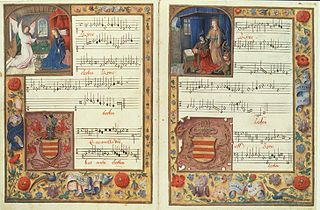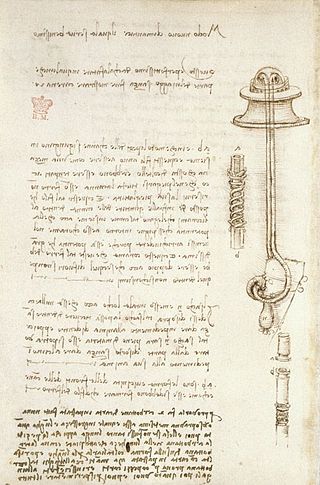Related Research Articles

The codex was the historical ancestor format of the modern book. Technically the vast majority of modern books use the codex format of a stack of pages bound at one edge, along the side of the text. But the term "codex" is now reserved for older manuscript books, which mostly used sheets of vellum, parchment, or papyrus, rather than paper.

The Cantigas de Santa Maria are 420 poems with musical notation, written in the medieval Galician-Portuguese language during the reign of Alfonso X of Castile El Sabio (1221–1284). Traditionally, they are all attributed to Alfonso, though scholars have since established that the musicians and poets of his court were responsible for most of them, with Alfonso being credited with a few as well.

Baldassare Galuppi was a Venetian composer, born on the island of Burano in the Venetian Republic. He belonged to a generation of composers, including Johann Adolph Hasse, Giovanni Battista Sammartini, and C. P. E. Bach, whose works are emblematic of the prevailing galant music that developed in Europe throughout the 18th century. He achieved international success, spending periods of his career in Vienna, London and Saint Petersburg, but his main base remained Venice, where he held a succession of leading appointments.
Antoine Brumel was a French composer. He was one of the first renowned French members of the Franco-Flemish school of the Renaissance, and, after Josquin des Prez, was one of the most influential composers of his generation.

Maya codices are folding books written by the pre-Columbian Maya civilization in Maya hieroglyphic script on Mesoamerican bark paper. The folding books are the products of professional scribes working under the patronage of deities such as the Tonsured Maize God and the Howler Monkey Gods. The codices have been named for the cities where they eventually settled. The Dresden Codex is generally considered the most important of the few that survive.

The Chigi codex is a music manuscript originating in Flanders. According to Herbert Kellman, it was created sometime between 1498 and 1503, probably at the behest of Philip I of Castile. It is currently housed in the Vatican Library under the call number Chigiana, C. VIII. 234.
Hilliard Ensemble was a British male vocal quartet originally devoted to the performance of early music. The group was named after the Elizabethan miniaturist painter Nicholas Hilliard. Founded in 1974, the group disbanded in 2014.

The Trecento was a period of vigorous activity in Italy in the arts, including painting, architecture, literature, and music. The music of the Trecento paralleled the achievements in the other arts in many ways, for example, in pioneering new forms of expression, especially in secular song in the vernacular language, Italian. In these regards, the music of the Trecento may seem more to be a Renaissance phenomenon; however, the predominant musical language was more closely related to that of the late Middle Ages, and musicologists generally classify the Trecento as the end of the medieval era. Trecento means "three hundred" in Italian but is usually used to refer to the 1300s. However, the greatest flowering of music in the Trecento happened late in the century, and the period is usually extended to include music up to around 1420.
Gherardello da Firenze was an Italian composer of the Trecento. He was one of the first composers of the period sometimes known as the Italian ars nova.
Jean L'Héritier was a French composer of the Renaissance. He was mainly famous as a composer of motets, and is representative of the generation of composers active in the early to middle 16th century who anticipated the style of Palestrina.

Antonio "Zacara" da Teramo was an Italian composer, singer, and papal secretary of the late Trecento and early 15th century. He was one of the most active Italian composers around 1400, and his style bridged the periods of the Trecento, ars subtilior, and beginnings of the musical Renaissance.

Falstaff – Symphonic Study in C minor, Op. 68, is an orchestral work by the English composer Edward Elgar. Though not so designated by the composer, it is a symphonic poem in the tradition of Franz Liszt and Richard Strauss. It portrays Sir John Falstaff, the "fat knight" of William Shakespeare's Henry IV Parts 1 and 2.
Jacques Brunel was a French organist and composer, active mostly in Italy.

Staffarda Abbey is a Cistercian monastery located near Saluzzo in north-west Italy; it was founded as a daughter house of Tiglieto Abbey in 1135 by Manfred I, Marquis of Saluzzo. The abbey became an important local centre for agriculture and held a flourishing market. It was placed in commendam to the Order of Saints Maurice and Lazarus in 1750.
Egardus was a European Medieval composer of ars subtilior. Almost no information survives about his life, and only three of his works are known. A certain "Johannes Ecghaerd", who held chaplaincies in Bruges and Diksmuide, may be a possible match for Egardus. The extant works—a canon and two Glorias—appear to be less complex than music by mid-century composers, possibly because they date from either very early or very late in Egardus' career.
The Trent Codices are a collection of seven large music manuscripts compiled around the middle of the 15th century, currently kept in the northern Italian city of Trent. They contain mostly sacred vocal music composed between 1400 and 1475. Containing more than 1,500 separate musical compositions by 88 different named composers, as well as a huge amount of anonymous music, they are the largest and most significant single manuscript source from the entire century from anywhere in Europe.
Huelgas Ensemble is a Belgian early music group formed by the Flemish conductor Paul Van Nevel in 1971. The group's performance and extensive discography focuses on Renaissance polyphony. The name of the ensemble refers to a manuscript of polyphonic music, the Codex Las Huelgas.

Codex Arundel is a bound collection of pages of notes written by Leonardo da Vinci and dating mostly from between 1480 and 1518. The codex contains a number of treatises on a variety of subjects, including mechanics and geometry. The name of the codex came from the Earl of Arundel, who acquired it in Spain in the 1630s. It forms part of the British Library Arundel Manuscripts.
The Modena Codex is an early fifteenth-century Italian manuscript of medieval music. The manuscript is one of the most important sources of the ars subtilior style of music. It is held in the Biblioteca Estense library in Modena.
Engarandus Juvenis, "Enguerrand the Younger" is a composer, presumed to be of French origin, whose three known works are all preserved in a single codex – the Codice di Staffarda – in the Cistercian monastery of Staffarda, Italy. He is notable as the composer of the earliest surviving example of a polyphonic setting of a Requiem mass complete with Dies Irae section.
References
- ↑ Description and inventory at DIAMM
- ↑ Gramophone - Volume 75 - Page 42 1998 "Daltrocanto's "Music from the Staffarda Codex" introduces a previously unrecorded Mass by Brumel, and one of the very first polyphonic Requiems, by the very obscure Engarandus Juvenis: ."
- ↑ Gramophone Classical Good CD Guide 1998 - Page 200 "... known of Engarandus Juvenis, the composer of this Mass for the Dead, whose music is found only in the Staffarda Codex."
- ↑ Basso, Alberto (1996). Booklet notes to CD "Il Codice di Staffarda" OPS 30-162. Paris: Opus111. pp. 12–13.